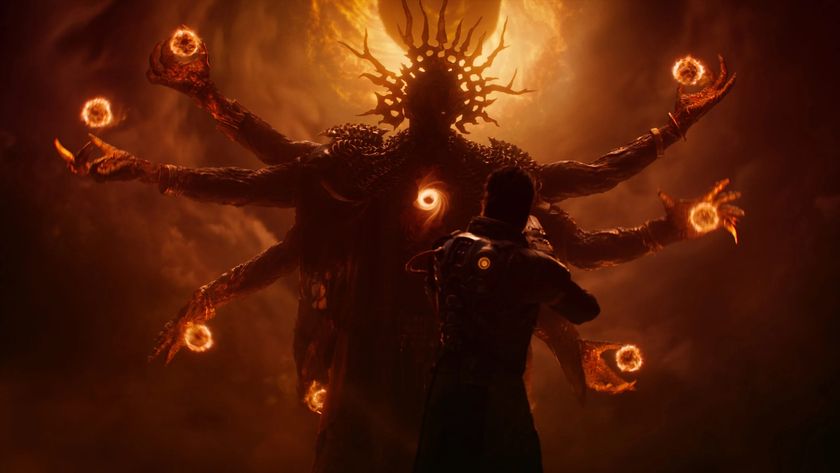The 2008 PC Builder's Bible
Find the best parts. Learn to build a rig from scratch and overclock it to kingdom come. PC Gamer shows you how
When the compact disc was introduced by Philips and Sony in 1979, vinyl records had the misfortune to be standing directly in its path. Those black, circular monstrosities—with their fragile surfaces and analog data—couldn’t compete with the CD’s deadly combination of digital clarity and rugged portability. A few years later, engineers figured out how to adapt audio CD technology for use with computer data by adding strong error detection and correction schemes, which led to the downfall of the floppy disk. This storage medium then evolved to DVD, which has taken over as the standard to distribute audio, data, and video to consumers. Today, it continues to evolve at an astounding pace.
Both CD and DVD drives fall under the banner of “optical storage.” These drives contain a laser, and when a disc is inserted, the laser “looks” at the surface of a disc, where information is encoded in a single spiral track that begins in the center of the disk and moves outward toward the edges. The laser is looking for variations in the surface of the disc, from which it derives digital data (ones and zeroes, in other words). The spiral track in a commercial CD-ROM contains a series of bumps and fl at surfaces called “pits” and “lands” embedded in a clear layer just below the disc’s outer surface. These “pits” and “lands” represent ones and zeroes and are the building blocks of data. Recordable CDs, or “burned” CDs, work in a similar way. Commercial, write-once and recordable DVDs use these same principles to store information.
Next-gen or not?
Optical technology is currently making another giant leap forward with the introduction of the next generation of storage discs: Blu-ray, which increases capacity from 4.5 and 8GB all the way up to more than 30GB using a blue laser instead of the traditional red one. But should this new format figure into your gaming system at this time?
For starters, a next-gen burner is a big investment. Prices have certainly dropped in the last year, starting at $1,000 or more a year ago and now resting at half that amount today. And that trend is sure to continue, so it may be worthwhile to wait for a while longer.
Yes, these drives are uniquely capable of burning huge amounts of data to a single disc (25GB per layer for Blu-ray), but the media is also quite pricey, running $12 to $15 dollars per single-layer disc and twice that for double-layer media. If data backup is your primary concern, an external drive might be more cost-effective purchase. And transfer times will certainly be more speedy, as even the fastest next-gen drive we’ve tested took more than 21 minutes to fill a 25GB disc—that’s not speedy, folks.
Indeed, the majority of your disc-burning needs might best be handled by a good, old-fashioned standard DVD drive. High-performance models, capable of speedy 18x burns, can be had for less than 100 bucks. And DVD media is itself very affordable. This can be a compelling stop-gap measure while you wait for “next-gen” optical to come into its own.
Sign up to the 12DOVE Newsletter
Weekly digests, tales from the communities you love, and more
Q: Does it make any difference what color or brand of media I use?
A: Which one should you use? That’s easy. Check the documentation that came with your optical drive, or the manufacturer’s website for media recommendations. These recommendations didn’t come about as a result of back-alley deals or bribes of exotic whiskey. You’ll find some media brands recommended over others because these discs have been specifically tested with the manufacturers’ drives. The proper laser strength for each type of media has been evaluated and programmed into the drive’s firmware.
In general, we do not recommend buying cheap spindles of off-brand media, no matter how inexpensive they are. El Cheapo vendors aren’t worried about brand loyalty, so they skimp on quality control and you pay the price in discs that are error-prone or that won’t retain their data for very long.
Q: Are non-combo, non-dual-format drives even relevant anymore? Why would anyone ever buy a dedicated DVD-ROM drive, CD-ROM drive, or CD-RW burner in this day and age?
A: Today’s optical storage market is divided among drives that record to CD-R, DVD-R, or both. Drives that do both are known as “combo” drives, while drives dedicated to recording in one format are called “dedicated” drives. A general rule of thumb is that dedicated drives tend to offer higher speeds than combo drives, but the speed differential is often negligible. But there are still good reasons to look at dedicated or single-format drives. For example, Plextor’s ultra-foxy PlexWriter Premium CD-RW drive doesn’t burn DVDs, but it offers a staggering amount of one-of-a-kind features, like the ability to tweak laser strength for higher compatibility with your audio equipment, and to “overburn” discs so that ordinary CDs can contain as much as 1GB of data.
Another reason to covet a dedicated drive is price. For example, if you know your set-top DVD player can read DVD-R discs, don’t waste your money on a dual-format burner when you can buy a less expensive single-format burner.
Dual-Layer
Some factory-pressed DVDs contain data on two layers for a total capacity of around 8.5 GB. While all DVD players, including DVD-ROMs, can fully access dual-layer discs, all current recordable DVD formats are based in single-layer technology and are limited to 4.7GB.

PC Gamer’s optical drive picks
Head back to the table of contents
PC Gamer is the global authority on PC games and has been covering PC gaming for more than 20 years. The site continue that legacy today with worldwide print editions and around-the-clock news, features, esports coverage, hardware testing, and game reviews on pcgamer.com, as well as the annual PC Gaming Show at E3.
Most Popular






